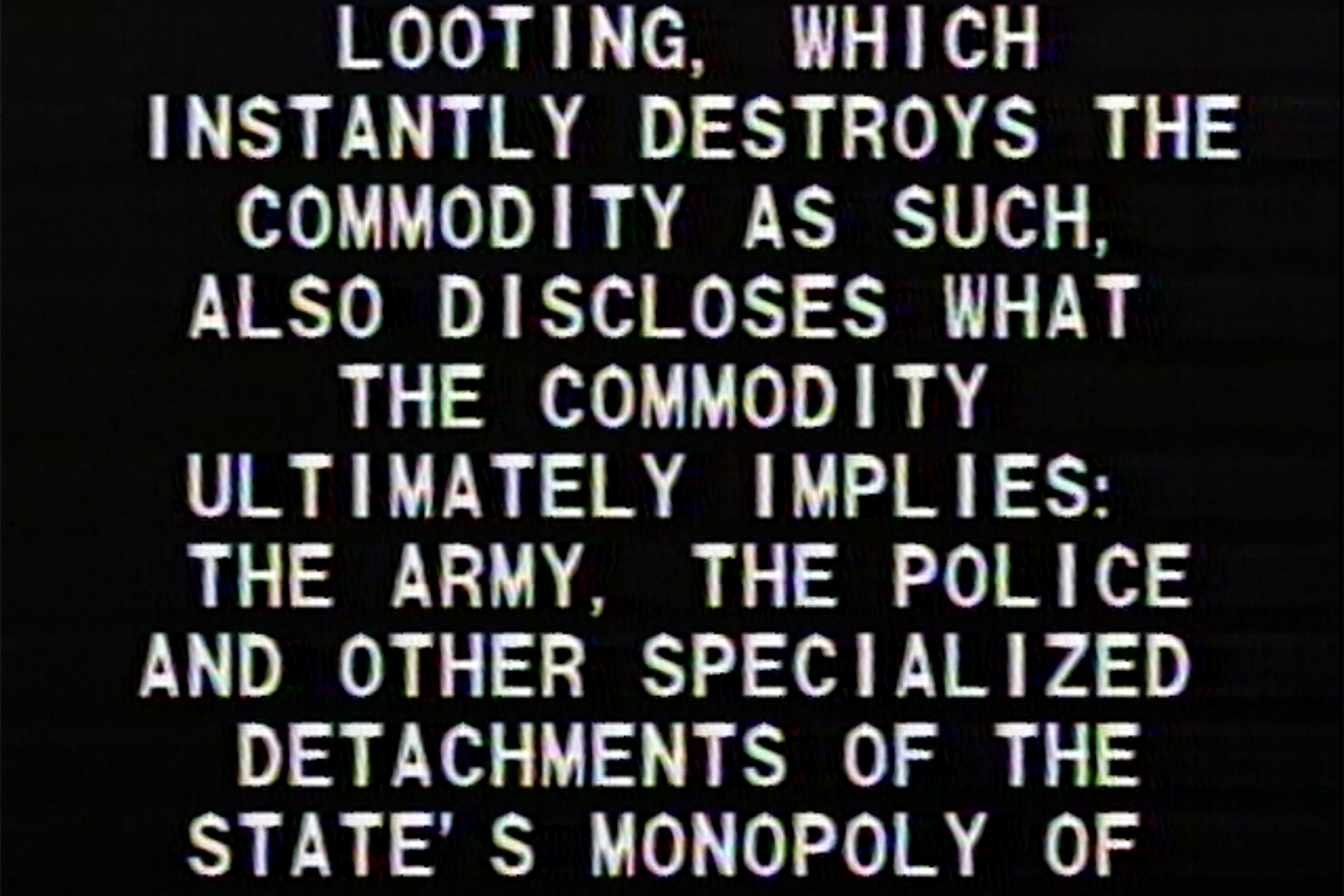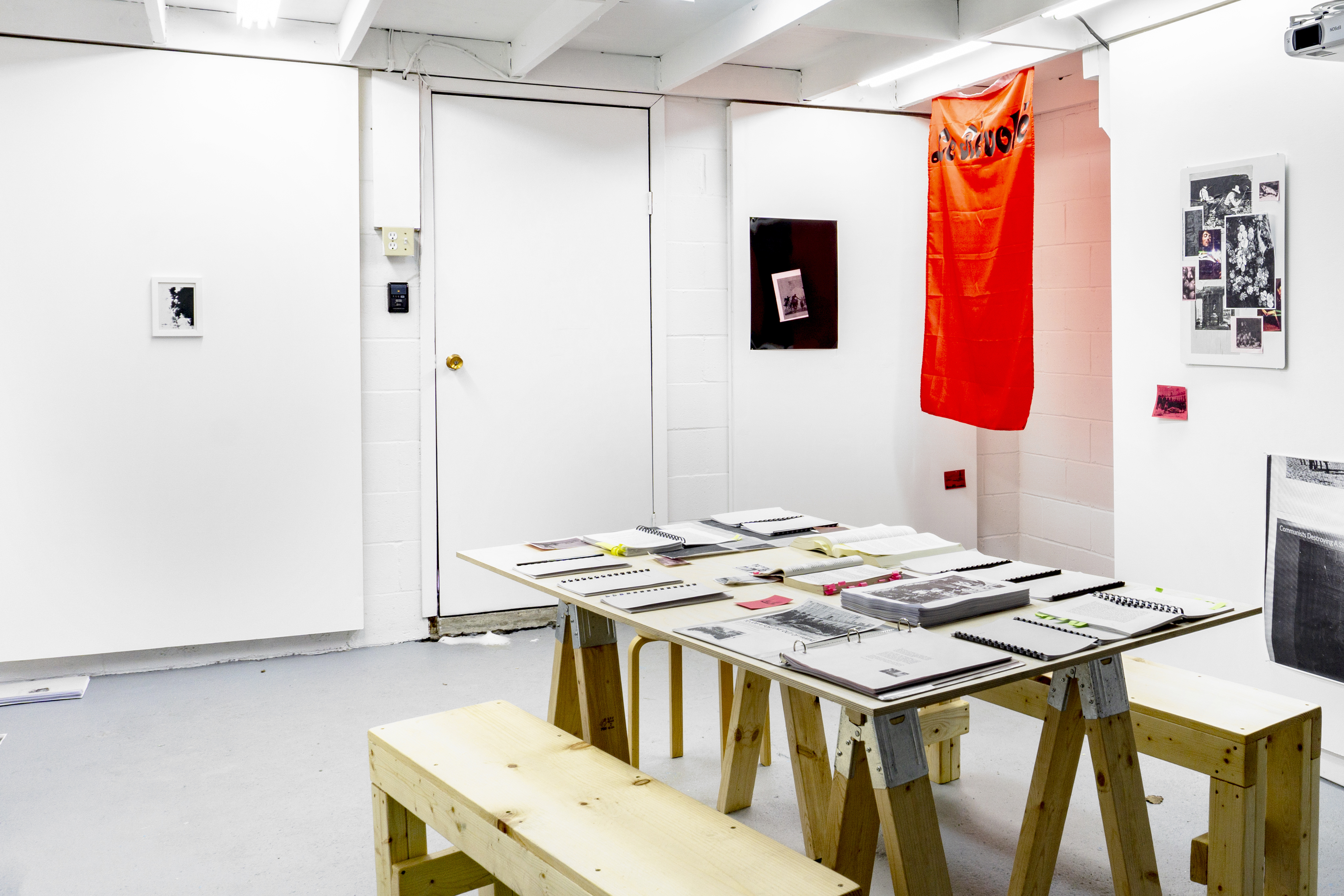
Installation view.
 Grayson Alabiso-Cahill, “Young Men at the Base of the Vendome Column Prior to its Demolition” (2019) c-print, 24” x 36”.
Grayson Alabiso-Cahill, “Young Men at the Base of the Vendome Column Prior to its Demolition” (2019) c-print, 24” x 36”. Still from Tony Cokes’ "Black Celebration" (1988) Digital video, 17:11 duration, b/w.
Still from Tony Cokes’ "Black Celebration" (1988) Digital video, 17:11 duration, b/w.
Grayson Alabiso-Cahill, “Pour Les Petroleuses” (2019) thermal label, 4” x 6”, open edition.

Installation view.

Grayson Alabiso-Cahill, “Roses, In Memory of the Paris Commune” (2019) Architecture print, 24” x 36”.

 Installation view.
Installation view. Grayson Alabiso-Cahill, Kenley Blackwood, “In Words and Parades” (2019) 5 x 8.5, cerlox bound, open edition.
Grayson Alabiso-Cahill, Kenley Blackwood, “In Words and Parades” (2019) 5 x 8.5, cerlox bound, open edition.FIRST A RADICAL, AND SECOND, AN OPTIMIST
GRAYSON ALABISO-CAHILLTONY COKES
CRUTCH CONTEMPORARY
Feb 08 — Mar 24
2019
Grayson Alabiso-Cahill is interested in radical mythologies, in the unruly birthplaces of popular uprisings, and in the rose-tinted and often troubling nostalgia of young and masculine leftism. The Paris Commune seems to mark the beginning of a new kind of political action; one that is photographed and surveilled; that is performed and propagandistic; that is celebratory and popular. The instability of both the photograph and the barricade play a role in how the narrative of the Commune is constructed, and this tension between urgency and historicity carries with it lessons to untangle in the present day. “First a Radical, and Second, an Optimist” will consider the fleeting moments of poetry, resilience, and improvisation that can be found in unabashed revolution. Using the gallery as an ad-hoc pedagogic site, this project takes the form of a transient installation, a series of workshops, and several multiples. The transiency of this installation nods to the ways in which any reading of a history is revisionist: punctum, narcissism, and instinct are used as tools by Alabiso-Cahill to guide his reading of an event that made a lasting impact on the superstructure of Socialist thought.
In “Black Celebration,” Tony Cokes merges newsreel footage of riots in the 1960s with popular music and text commentary to create a counter-reading of rioting as a refusal to participate in the logic of capital, as an attempt to de-fetishize commodity through theft and gift. Subtitled “A Rebellion against the Commodity,” this reading of the urban black riots of the 1960s references Guy Debord’s Situationist text “The Decline and Fall of the Spectacle-Commodity Economy” alongside commentary adapted from Barbara Kruger, Morrissey, and the Canadian Industrial band Skinny Puppy. Tony Cokes’ practice questions how our modes of political and civic articulation are guided and shaped by media image circulation, and how that in turn defines the horizon of emancipatory struggles. Asking audiences, “How do people make history under conditions pre-established to dissuade them from intervening in it?”
Grayson Alabiso-Cahill (born 1996, Philadelphia) lives and works in Toronto.
Tony Cokes lives and works in Providence, Rhode Island. Recent exhibitions include the 10th Berlin Biennale in Berlin; Hessel Museum in Annandale-on-Hudson; the Whitechapel Gallery in London; ZKMin Karlsruhe; REDCAT in Los Angeles; SFMOMA in San Francisco; the Whitney Museum of American Art in New York; the Pera Museum in Istanbul; and the Louvre in Paris.
Collaged
by Grayson Alabiso-Cahill
In Words and Parades
by Grayson Alabiso-Cahill, Kenley Blackwood